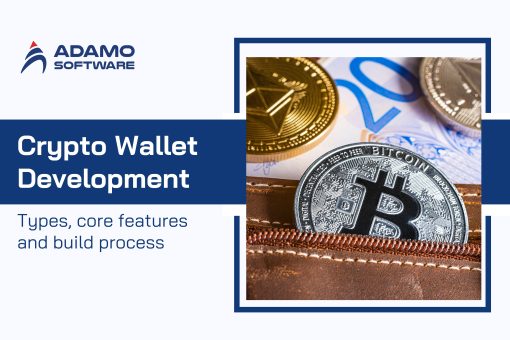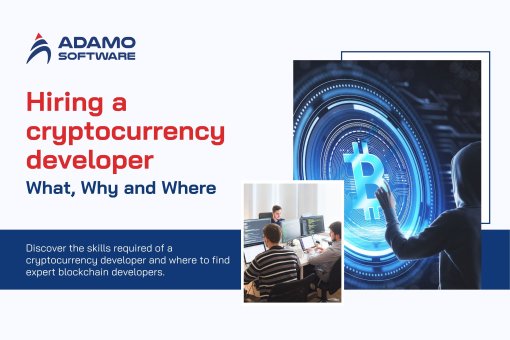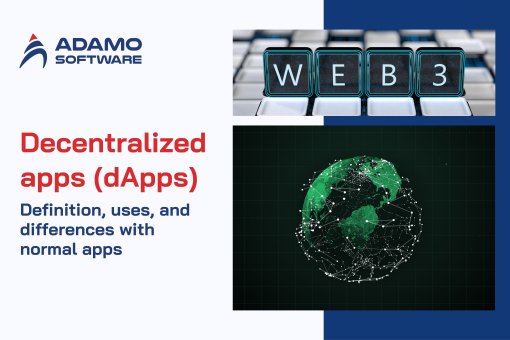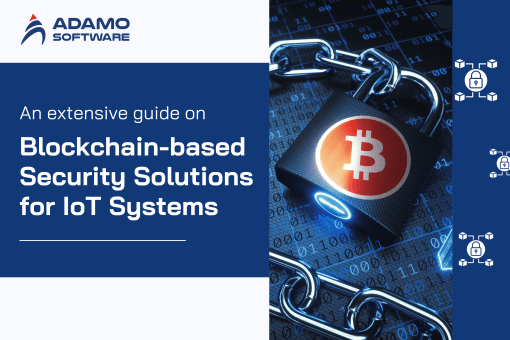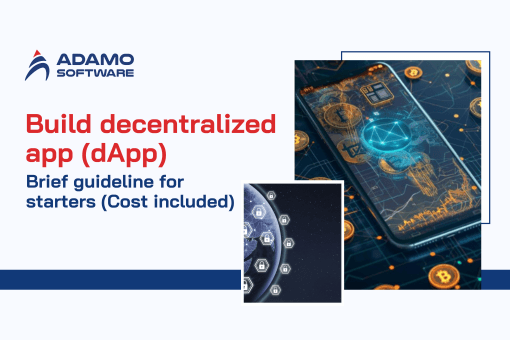Blockchain application development: Tech stacks and DApp integration methods

Blockchain technology stores and transmits data information using blocks. Currently, many industries have adopted this technology thanks to its robust security, accountability, and decentralization. Besides Bitcoin, some sectors like financial services, operation management, healthcare, and education, are also using Blockchain in their operation. Building blockchain apps means making systems that keep data safe in encrypted blocks. With blockchain technology, the system can maintain its stability.
Additionally, organizations using blockchain can enhance their system’s security and reliability. So, what are notable tech stacks and DApp integration methods for blockchain application development? Let’s find out the answer with Adamo Software!
By reading this blog post, you can get more insights about the tech stacks in blockchain application development and their challenges. Besides, how to integrate a DApp with your business will also be discussed. All information has been carefully researched and updated to the latest trends. So, let’s read our blog post and find useful information for you!
I. What is the technology stack in blockchain application development?
Organizations use the technology stack in blockchain application development to create, deploy, and manage a blockchain application. This set of technologies encompasses many tools and software frameworks. The tech stack in blockchain application development has four layers. They are corresponding to the 4 levels of the blockchain. They include the infrastructure layer, protocol layer, service layer, and application layer. Let Adamo Software discuss each layer.
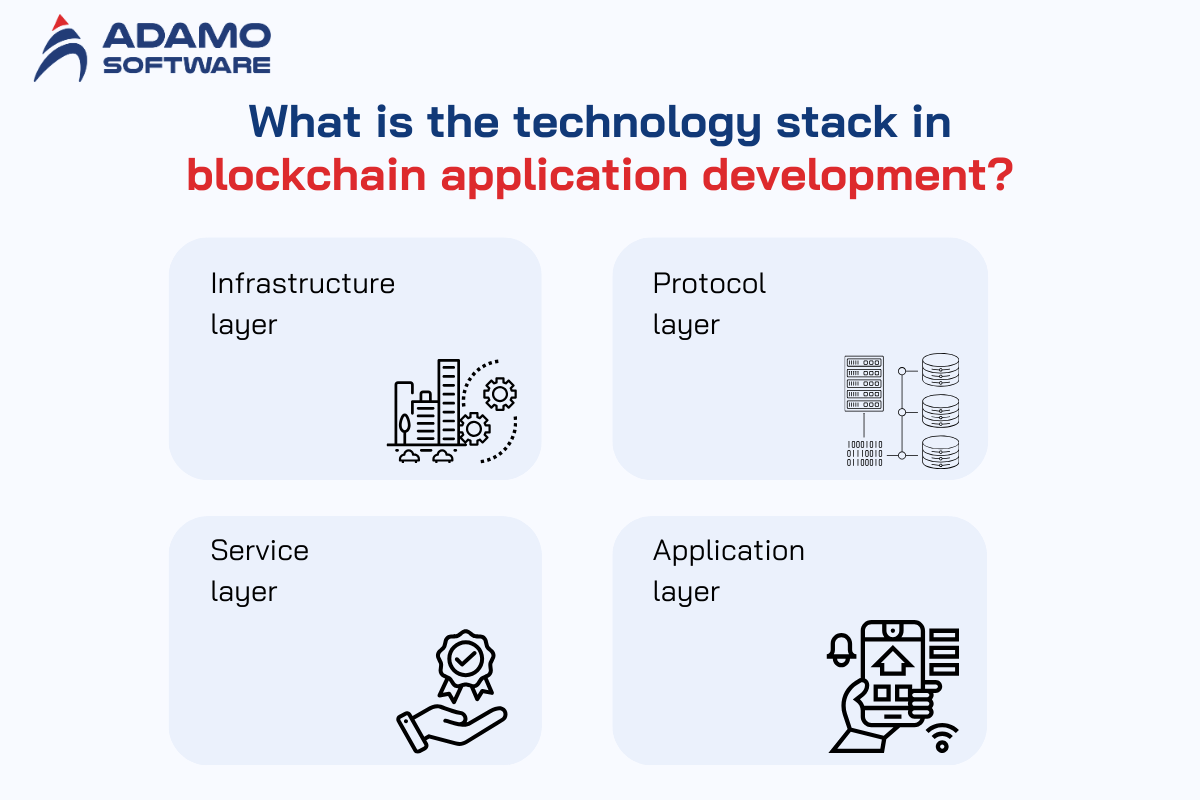
1. Infrastructure layer
Organizations need to implement the infrastructure layer to establish and maintain blockchain platforms. Ethereum, Hyperledger, and Solana are the three most notable blockchain platforms in this layer. The infrastructure layer also includes consensus protocols. Developers often use Proof of Work, Proof of Stake, or Delegated Proof of Stake. These factors enable blockchain use, smart contract execution, network security, and consensus.
2. Protocol layer
The protocol layer of the technology stack in blockchain application development contains the protocols and algorithms that manage the operation of the blockchain. It helps run smart contracts and control the network rules. Developers utilize Solidity on Ethereum and Rust on Solana to create smart contracts and deploy decentralized applications (DApps) on blockchain networks. Besides, they also favor Go, JavaScript, Python, and C++. The protocol layer also has APIs like Chainlink or Infura and SDK toolkits. They play an important role in helping Blockchain applications interact with other systems, integrate external data, or provide services.
3. Service layer
The service layer helps to develop decentralized applications and the tools that support their development and deployment. Tools like Truffle, Hardhat, and Remix IDEs help developers test, debug, and deploy smart contracts easily. Although Blockchain stores data in a decentralized manner, applications need to add external databases like MongoDB or PostgreSQL to store data that does not need absolute decentralization or temporary data.
4. Application layer
The application layer is the most important layer of the technology stack in blockchain application development. This layer is where Blockchain applications are used by end users, including the user interface and interactive experience. Developers may use React, Angular, or Vue.js to build interactive interfaces. These tools can help make the application user-friendly and intuitive. Users can interact with Blockchain using smart contract wallets like MetaMask or Trust Wallet.
Overall, the Blockchain application development technology stack is tightly organized into 4 above levels. Each level plays an important role in creating a complete and efficient Blockchain system.
II. Tech stacks for blockchain app development
As mentioned, the tech stack for blockchain apps includes tools, languages, frameworks, and services that help build and deploy decentralized applications. Let Adamo Software discuss some main components of the tech stacks commonly used in Blockchain application development.

1. Blockchain platforms
Developers utilize blockchain platforms to deploy DApps and smart contracts. Each platform offers different characteristics and features. Developers can choose a suitable platform based on the requirements of the app they are developing. Below are some popular blockchain platforms for the tech stack in blockchain application development.
- Ethereum
Ethereum is among the most popular platforms. It can run smart contracts and deploy a large number of decentralized applications. While it brings many benefits, it costs and time to get familiar with the system can be its drawback.
- Solona and Binance Smart Chain (BSC)
Solona and BSC may be alternatives to Ethereum. They have lower costs and better scalability, thanks to the ability to process thousands of transactions per second.
- Hyperledger
Hyperledger is an enterprise-specific platform focused on privacy and security in internal environments. Therefore, it doesn’t have public transaction costs like public Blockchain platforms. The costs depend on each organization’s infrastructure and implementation.
- Polkadot and Cardano
Polkadot and Cardano are also notable blockchain platforms. They emphasize interoperability between different blockchains and sustainable development.
Overall, the diversity of platforms creates a wide range of options for applications ranging from finance, and supply chain management, to education and healthcare. Depending on the project goals and scalability, each platform offers its own advantages for blockchain application development.
2. Programming languages
Programming languages are used to build smart contracts and business logic in blockchain application development. Here are a few popular programming languages to consider.
- Solidity
Solidity is a widely used language for Ethereum. It is capable of handling complex logic and interacting directly with the Ethereum Virtual Machine to create robust decentralized applications. This programming language can be easily accessed by many web developers.
- Rust
Rust is the language commonly used in Solana. It stands out for its performance optimization and high memory safety. Rust supports building applications with superior performance, suitable for systems that require processing many transactions at the same time, helping Solana achieve high speed and low fees.
- Go (Golang)
Go (Golang) is a widely used programming language in Hyperledger, thanks to its powerful and efficient concurrency capabilities. This programming language is highly suited for building large enterprise systems that require high scalability and good synchronization between system components.
- JavaScript and Python
JavaScript and Python are commonly used in front-end and API development, connecting user interfaces to smart contracts and data from Blockchain. While JavaScript is popular thanks to the strong growth of front-end frameworks like React, Python is ideal for tasks involving data analysis and rapid testing thanks to its easy learning curve and simple syntax.
3. Databases
Although Blockchain stores distributed data, Blockchain applications still need traditional databases to manage off-chain data. IPFS, MongoDB, and PostgreSQL are the three most familiar solutions in blockchain application development for off-chain data. Let’s learn some general information about these database solutions.
- IPFS (InterPlanetary File System)
IPFS allows users to store and share large files without relying on a central service. It does not depend on the central servers. Instead, it distributes data across nodes, which increases security and censorship resistance. This solution is especially suitable for Blockchain.
- MongoDB
MongoDB is a cross-platform, open-source database built with C++. It is ideal for applications requiring flexible data storage and retrieval. MongoDB allows developers to store and manage data with dynamic structures. This makes it easy for Blockchain applications to scale and handle varying off-chain data requirements.
- PostgreSQL
PostgreSQL is a powerful SQL database, featuring the ability to handle complex transactions and support data integrity. It is widely used in Blockchain applications that require managing structured data and performing complex queries. It offers high security and reliability for systems demanding data consistency.
4. Application programming interfaces (APIs)
APIs are useful to connect blockchain applications to other services. Developers might explore Infura, Chainlink, or Alchemy as potential tools. These tools can create and launch decentralized applications (DApps) on blockchain networks.
- Infura
With Infura, developers can connect to the Ethereum network without needing to maintain their own nodes. This system allows users to access blockchain data and interact with smart contracts. It’s ideal for developers building Ethereum applications efficiently and cost-effectively.
- Chainlink
Chainlink enables smart contracts to access and utilize real-world data. This tool enables blockchain applications to use external data to trigger smart contracts.
- Alchemy
Alchemy is a platform for building and managing decentralized applications. It’s a popular choice for developers due to its stability, ease of use, and ability to handle large projects. Alchemy is outstanding with its performance monitoring and analytics features. This makes it easy for developers to debug and optimize their DApps.
5. Deployment tools
Deployment tools are essential in blockchain application development, especially for smart contracts and DApps. These tools help developers create, test, debug, and deploy applications efficiently. Below are some main tools used.
- Truffle
Truffle provides a comprehensive development environment with features like contract compilation, deployment, automated testing, and network management. It makes development easier with simple commands, supporting both test net and main net deployments.
- Hardhat
Hardhat is outstanding with its robust debug capability and integration with other tools like Ethers.js and Waffle. It allows developers to create an internal blockchain network to monitor and detect errors.
- Brownie
Brownie is a smart contract development framework on Ethereum, written in Python. It supports convenient testing, debugging, and deployment of smart contracts, with good integration with the Web3.py library.
In general, blockchain application development tech stacks include various technologies from platforms, programming languages, databases, APIs, and deployment tools. The choice of tech stack depends on project requirements, scale, and application type.
III. Challenges you may face in blockchain software development services
When building blockchain software, businesses may face various issues related to technology, security, development and deployment costs, etc. Let Adamo Software discuss some main challenges you may face in blockchain application development services.

1. Difficulty in understanding and applying new technology
Blockchain is a new and complex technology, requiring developers to constantly update their knowledge of related platforms, programming languages, and development tools for blockchain application development. A lack of experience or deep understanding of Blockchain can lead to errors in system design and implementation.
2. Security problems
Security is one of the most important factors in blockchain application development. Security vulnerabilities can lead to loss of assets and sensitive information. Therefore, developers need to master security measures, carefully review source code, and apply strong encryption methods.
3. Compatibility challenges with existing systems
Integrating blockchain into complex systems can be challenging. Developers need to understand existing systems and how they work with blockchain.
4. Developing and deployment costs
The initial cost for blockchain application development can be high. This is due to the manpower, technology, and time requirements. When developing the blockchain app, developers must carefully evaluate their budget and development plan. This helps to avoid cost overruns.
5. Data management and legal regulations
When building Blockchain applications, blockchain developers must prioritize data management and legal compliance. This is particularly crucial for applications that handle financial or sensitive data, as regulations may differ between jurisdictions.
6. Scalability
Blockchain scalability can be a challenge as usage grows. Developers must design systems that scale efficiently without compromising performance or reliability.
7. Reliability of external services
Many blockchain applications require external data from oracles. However, the reliability and accuracy of these services can affect the entire system. Therefore, the selection and integration of external services must be done carefully to ensure smooth blockchain application development.
8. Public/ Private network issues
Blockchain application development may face difficulty in choosing between public networks and private networks. Public networks allow everyone to participate, ensuring decentralization and transparency. However, it can face difficulties in transaction speed and high costs. In contrast, private networks provide more security and speed due to strict control, but lack transparency and decentralization, leading to trust risks. Selecting the appropriate network type requires careful consideration of the specific requirements of the project and organization.
Overall, Blockchain technology offers benefits but also presents challenges. Developers must address these challenges for efficient and secure blockchain application development.
Also read: How to develop a blockchain application: An 8-Step Comprehensive Guide
IV. How to integrate a DApp with your business
Integrating a decentralized application into your business during the blockchain application development process can bring many benefits. For example, you can enhance the security of the system and improve customer experience. But how can you integrate a DApp with your business? Let’s find out some main steps with Adamo Software!
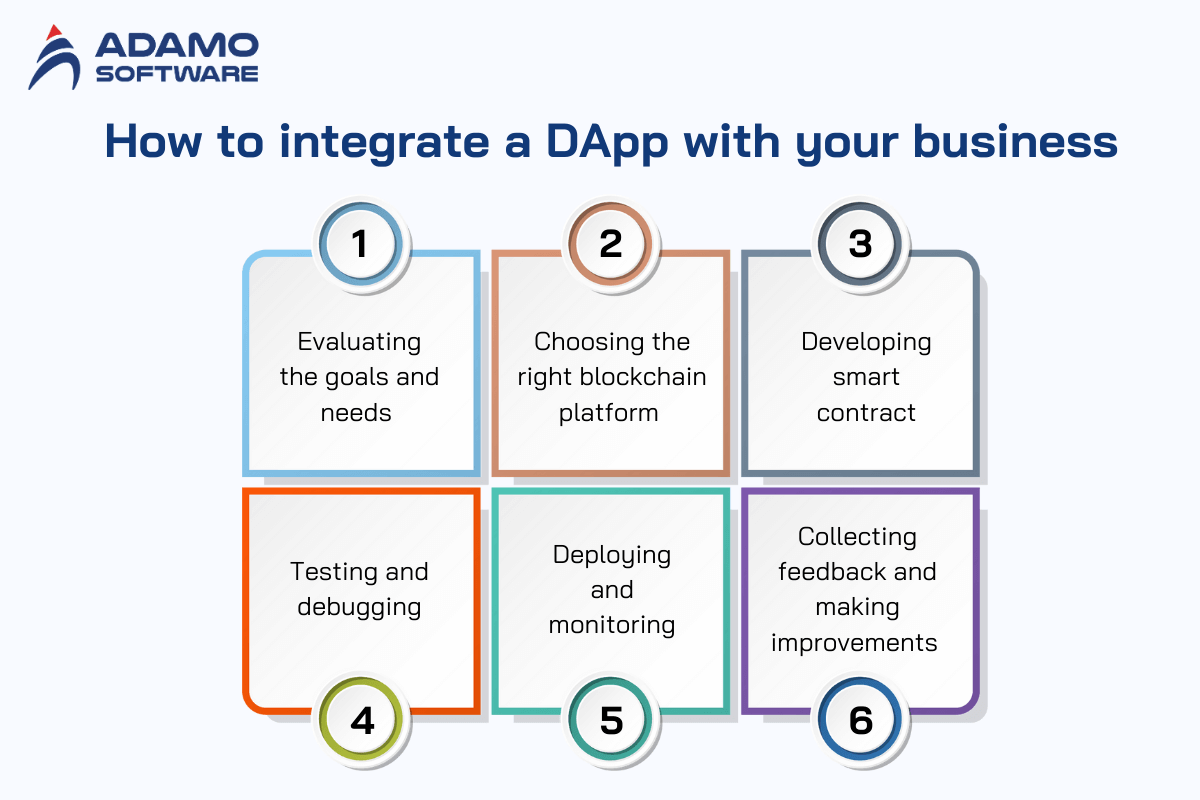
1. Evaluating the goals and needs
First, businesses need to clearly identify their specific needs and goals when integrating DApps. It could be enhancing transaction security, improving transparency, or optimizing business processes. When the organizations understand the reasons for integration, they can make the right decisions throughout the implementation process.
2. Choosing the right blockchain platform
Businesses need to choose a Blockchain platform that suits their needs and goals for blockchain application development. These platforms, as mentioned above, can be Ethereum, Binance Smart Chain, or Hyperledger. The firms need to choose the platform based on each platform’s features, cost, and scalability.
3. Developing smart contract
A smart contract is an important part in DApps, automating processes and transactions without the need for third-party intervention. Businesses need to work with experienced Blockchain developers to design and implement smart contracts, ensuring they function properly and securely.
4. Testing and debugging
Before deploying a DApp, businesses need to conduct thorough testing and debugging to detect and fix bugs or security issues. This helps them enhance performance and ensure the safety of customer data and transactions.
5. Deploying and monitoring
After finishing testing, businesses can now deploy DApps on their chosen blockchain platform. After deployment, monitoring the DApp’s performance is very important to promptly detect arising issues and improve performance.
6. Collecting feedback and making improvements
Collecting feedback and making improvements is the last step in integrating Dapps for your business during the blockchain application development process. Businesses should collect feedback from users to evaluate the effectiveness of the DApp. Based on the feedback, businesses can make necessary improvements to enhance the user experience and performance of the application.
In general, integrating Dapps into businesses can be a complex process. However, if the businesses follow step by step, they can make the most of the benefits that Blockchain technology brings.
V. Develop Blockchain apps with Adamo Software
Having difficulties with your blockchain application development? Then, you will need a reliable unit that can help you with your problems. As one of the leading technology companies in Vietnam, Adamo Software is confident that we can bring you the best solution. Here’s how we can help you develop a blockchain application for your business.
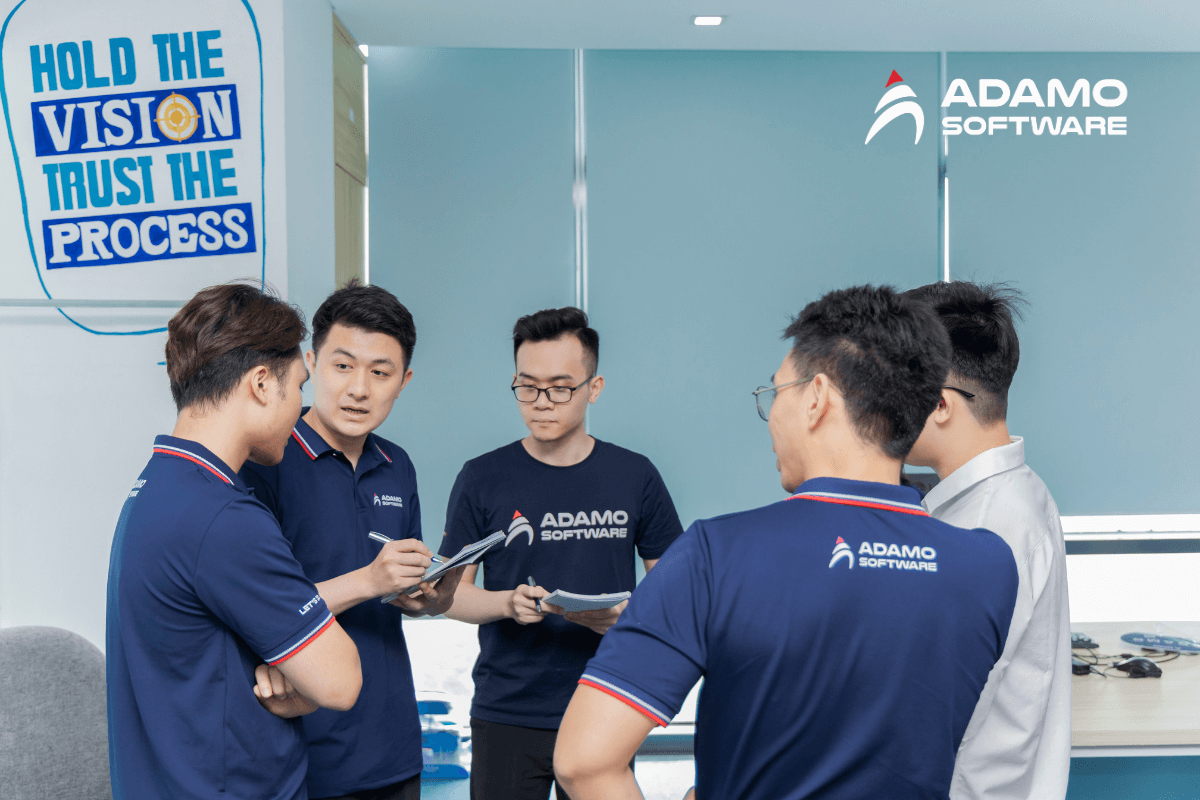
- Building blockchain applications on various platforms
With an experienced team, Adamo Software can help you build blockchain applications on various platforms, such as Ethereum, Binance Smart Chain, Hyperledger, etc. This helps ensure that your blockchain application development is delivered with precision, safety, and optimal performance.
- Developing custom smart contracts
Adamo Software specializes in developing custom smart contracts that are tailored to the specific needs of each business. Smart contracts developed by Adamo ensure high security, process automation, and minimal third-party intervention.
- Flexible and easy integration
With experience in integrating Blockchain into existing enterprise systems, Adamo Software makes the transition smooth. Developed Blockchain applications have the ability to flexibly integrate with management tools, financial systems or third-party services, optimizing workflows.
- Security and Compliance
Security is always a top priority for Adamo Software. The Adamo team not only ensures that the source code is thoroughly tested but also focuses on legal regulations related to Blockchain.
- Post-deployment support
In addition to development, Adamo Software also provides support and maintenance services after the project is deployed. Adamo’s team is always ready to handle arising issues, improve performance, and ensure that your Blockchain application operates smoothly and securely throughout its lifecycle.
Still hesitate in choosing? Don’t worry, let’s contact our Adamo Software team for more detailed information and solutions for your blockchain application development.






